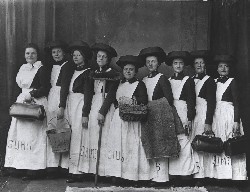
Slum posts were staffed by teams of women Salvationists who were known as slum sisters.
© Salvation Army Heritage Centre

Knocking on people's doors with offers of help was the "chief work" of the slum sisters.
© unknown
By Natasha Lewer
Slum sisters at work
‘Slum posts’ were set up, under the charge of Staff Captain Osborne, who in the early 1890s was responsible for 16 slum posts throughout London. In Hackney, there was a slum post in Mallard Street, Hackney Wick and another in Oswald Road, Clapton. Interviews with the women officers who worked there – known as ‘slum sisters’ – give us a detailed picture of the work they carried out.
These slum posts were typically a small terraced house, with the upstairs bedrooms being shared by two Salvation Army officers (who received a wage) and three or four trainees (who were unpaid), while the ground floor would be used for holding meetings. These religious meetings were held once or twice a day on weekdays, and throughout the day on Sundays, and were attended by a mixture of the devout, the curious and the bored. Local children often hung around the front door causing a nuisance and would have to be shooed away.
Hallelujahs in the park
Meetings were also held in the open air, on Hackney Marshes, London Fields and other open spaces, though frequently the Salvationists would be competing against other religious groups singing their own hymns, and rowdy children shouting irreverent hallelujahs.
As well as holding religious meetings, they ran Sunday schools, visited public houses to speak against the evils of drink, prayed in brothels, patrolled the streets and parks on the lookout for ‘vulnerable’ women, and delivered copies of the Salvation Army newspaper The War Cry.
The visitations
Their “chief work”, however, according to Miss Osborne, was “the visitations”. This involved knocking on the doors of families in the area and helping out in whatever way they could: tending to the sick, scrubbing the floor, or simply providing advice. Captain Smith, in charge of the Mallard Street slum post in the early 1890s, is quoted as remarking ruefully that though they do not give much [financial] relief – being only allowed two shillings a week by Salvation Army headquarters - they do what they can to help.
Slum nursing
The slum sisters were not initially trained in nursing, but it soon became apparent that there was a need for this, and in the early 1890s William Booth arranged for a trained nurse to be stationed at each slum post in addition to two officers. In 1894 or 1895, Florence Soper Booth put Caroline Frost in charge of the ‘Slum Nursing’ programme, with headquarters at 46 Tudor Road, south Hackney. The trainees learnt about midwifery and sat in on medical lectures at the Royal London Hospital, so as to be better equipped for nursing in the local community.
Scarlet collars and princess bonnets
The slum nurses wore distinctive brown linen uniforms, "with scarlet collars and cuffs, a dainty white apron, cap and elbow cuffs for indoors. Outdoors the long blue cloak and tiny princess bonnet, with white strings, are worn,” according to a newspaper report of 1898.
Later, nursing posts were established at 67-9 Nichols Square, Hackney Road and 368 Wick Road, Hackney Wick. The slum nursing programme came eventually to be known as ‘district nursing’.
Click here to read more about Caroline Frost , in charge of the slum nursing programme.
Photograph of slum sisters out on a visit reproduced courtesy of www.workhouses.org.uk.